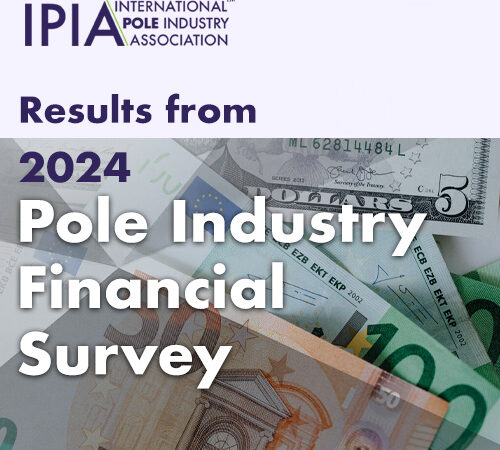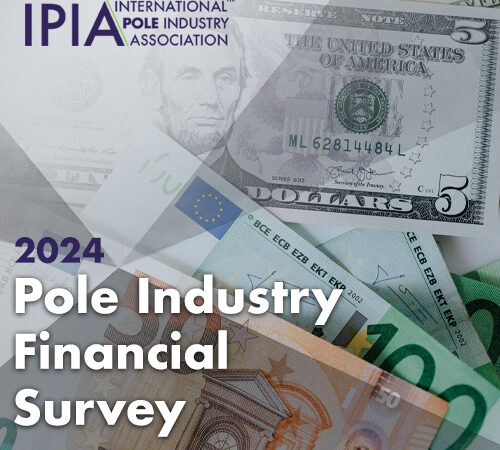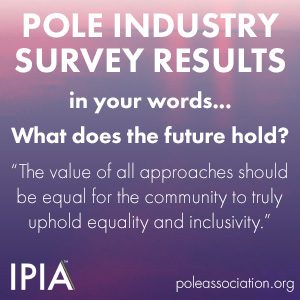The Pole Industry Financial Survey (PIFS) is here so we can better understand the financial…

2024 Pole Industry Financial Survey Results
Thank you to everyone who took our second pole industry financial survey! (see results from the first survey here)
Our goal with collecting this data is to help people make informed decisions about their businesses in the pole industry and to help those not yet in the industry to better understand the market before entering.
Survey Structure
This was a sprawling survey that covered some basic demographic information.
Then, it asked specific questions relevant to the five categories of pole industry businessperson currently recognized by the IPIA. Some questions were repeated with slight tweaks, such as types of revenue and expenses while other questions were specific to each category.
Questions for current or future pole industry professionals such as: “What should I charge for classes?” or “How much money can I make as a pole performer?” can be answered using this data.
Does this survey represent everyone? No, not yet. It does begin to establish a baseline to build from as an industry.
Survey Updates
The 2024 survey took many questions from the 2022 survey AND added additional questions as well as the ability to provide more open-ended answers. The opened ended answers are awesome as they give us so much more detail, but they make it hard to compare directly.
We increased the number of respondents by 36% and had representation from North America, Australia, and Europe.
Respondents were able to choose their currency when responding. Those responses have been converted to US dollars to make the data more comparable across this data and the 2022 data which was in US dollars.
Click here to view all the results.
Below are the survey highlights. At the end of these results are some positive and concerning trends.
Highlights from general demographic data (Questions 1-11)
- 151 people took the survey. Most respondents (86.67%) are from North America, and the next largest population of respondents are from Europe (9.33%). **compared to the previous survey, more people from North America took the survey this time and the overall number of people taking the survey increased.
- The survey asked new demographic data including about mental and physical conditions or disabilities, and 23.65% of respondents affirmed they did have a mental or physical condition that impacts their work life.
Highlights from the survey broken out by category
Here are some interesting highlights from the pole studio owners questions (Questions 12-41):
- Most people who generated a profit for their studio did so in 3 years or less. Only 15% of respondents never generated a profit. **consistent with the previous survey.
- Most studio owners also taught at their studios. **consistent with the previous survey.
- Studio owners spent significantly more time on admin work than teaching at their studio. **this has not held true this year. Studio owners seem to spend a mix of time teaching a well as on admin and/or marketing.
- Most studios (>46%) were in suburban areas. **this decreased slightly from last year percentagewise but is still the highest.
- Interestingly, hired teachers were split almost equally between part-time employees 42% and contractors 52%. **consistent with the previous survey. In 2022, the split was exactly 43%. Full time pole instructor employees seem rare.
- The most common hourly rate for teachers at studios was between $21-25/hr. **consistent with the previous survey.
- The average number of students per class was 6-10.
- Single classes cost on average between $21-30/class, which was consistent between pole and non-pole classes. **this is consistent with the previous survey
- Most pole studio owners (53%) did not have any debt.
- Most pole studio owners have some savings, but it varies wildly.
- Most studio owners are thriving (63%).
Here are some interesting highlights from the pole instructor questions (Questions 42-57):
- Pole instructors have a lot of longevity in teaching, with 45% teaching 7 or more years.
- Most, but not all instructors, had insurance to teach pole (86%) either through individual coverage or by their studio. **an improvement from the previous survey which was only 71%!
- Instructors reported their most popular classes were intermediate pole, followed by intro pole, and choreography-based pole. Heels—beginner and flow—as well as advanced pole and chair were also popular. Meanwhile flexibility classes were one of the most commonly taught classes (other than pole) but were perceived as less popular.
- Most (84%) pole instructors did not have any debt related to their pole instruction business.
- Most (56%) pole instructors also did not have any savings related to their pole instruction business.
- Most pole instructors are maintaining their business (62%). It is interesting that more studios report they are thriving but less instructors report the same thing.
- The average payment for classes was $21-30/hr. **consistent with the previous survey.
Here are some interesting highlights from the pole business questions (Questions 58-77)
- Most pole businesses have been in business for 4-6 years (40%). **it has been 2 years since the last survey and these businesses seem to have continued growing. Still, they are young businesses, compared to instructors or studio owners who have been in business longer.
- Most pole businesses (58%) spend an average of 1-20 hours on their business. **this is different from last survey when they were split between spending a lot of time on their business (41+ hours per week for 27% of respondents) or very little (1-5 hours per week for 23%).
- Most pole businesses (60%) employ contractors and provide free items to their staff as a benefit. **consistent with the previous survey.
- Half of pole businesses (50%) were thriving.
Here are some interesting highlights from the performer questions (Questions 78-93):
- Most performers (77%) had been in business for 6 or less years. **compared to last survey when most performers (40%) had been in business for more than 10 years.
- Most performers (90%) were not in any unions or groups like SAG. **this is less than the survey which was 96%.
- Most performers were not performing weekly, **the previous survey saw performers performing 1-3 hours per week, this is a downtrend.
- Most performers charge an average of $50-200 for performance (a performance on average being 1-4 hours including warm-up, call time, etc.). **consistent with the previous survey.
- Most performers (61%) were paid in a combination of a flat fee and tips. **consistent with the previous survey.
- Half of performers (55%) were maintaining their business.
Here are some interesting highlights from the stripper/sex worker questions (Questions 94-104):
- Most strippers/sex workers (83%) have been in business 10+ years.
- Most strippers/sex workers (40%) worked 0-10 hours per week and most (80%) made $201-500 per night or session. **consistent with the previous survey.
- Strippers/sex workers were divided, 40% are thriving and 40% are struggling.
Here are some interesting highlights from the summary questions (Questions 105-110):
- Most people in the pole industry (80%) have other employment related income.
- Most of that income (71%) is full time work of some sort.
- Most people in the pole industry (55%) make between $25K-75K per year total income (pole and non-pole).
- Some (mostly $300 or less) of other income goes to support an individual’s pole business.
- Most people feel “neutral” overall about their current financial security and income.
- Most people would like support increasing their revenue in the pole industry.
Concerning potential trends from the survey
Some demographics report spending some money on marketing and continuing education, but not all. There may be more opportunities to improve your business if you spend time and money investing in building the business of your business, rather than working in your business (such as providing pole instruction). There may also be opportunities to provide low-cost education (such as IPIA resource posts and $5 webinars) to help people bridge this gap between money, time, and access to information.
There is a huge range of debt and savings across all the demographics. Some people have a lot of savings and little debt, while others have very little debt and a lot of savings. Based on how the questions were answered, it is unclear if these are pole-specific or if they represent the person’s wholistic savings/debt amounts.
While more people took the survey overall, the survey is still skewed towards North America and white people (55%).
Most people who take the survey are pole instructors or studio owners with the least amount of representation in the other demographics of pole business, performer, stripper/sex worker. There may be opportunities in the future to do more targeted outreach to those groups or to partner with groups that focus on serving those demographics. (Check out BlackStage’s work around paid performing work)
Positive potential trends from the survey
Last survey we were concerned that not all pole instructors had insurance, this has improved since last survey significantly!
Although our industry is still young, there is a positive longevity trend for instructors, studio owners, performers, and strippers who have been in business for more than 10 years. Congrats!
*This has stayed consistent in general and the pole business years in business number has increased which is also very positive!
There are also positive trends about generating profit with few businesses saying they never generated a profit in their businesses. Sometimes all we hear about is bad news, so hearing that there is longevity and profit potential for most people in our industry is exciting and positive!
*This has stayed consistent from the previous survey as well!
The path forward
For this second survey, we created more open-ended questions which did not provide as much insight as we thought they would. In reality, it created a significant amount of data clean up and not as many clear comparisons. Although comparisons did emerge, and a significant number of continuing trends can be seen in the structure around pole classes (for instance). We invite others to explore the data and see how it can be useful in your business.
In general, more support is needed for all pole businesses as the industry continues to grow. While the desired/reported focus is on revenue, more education and marketing can also play a huge role in improving this industry. The more people know where go to for help, the faster they can improve and grow their businesses.
The IPIA will run another broad survey in two years to again “take the pulse” of the industry and continue providing low-cost education and support for pole businesses primarily through resource posts and webinars.
Is there something we can help you with? Let us know!



